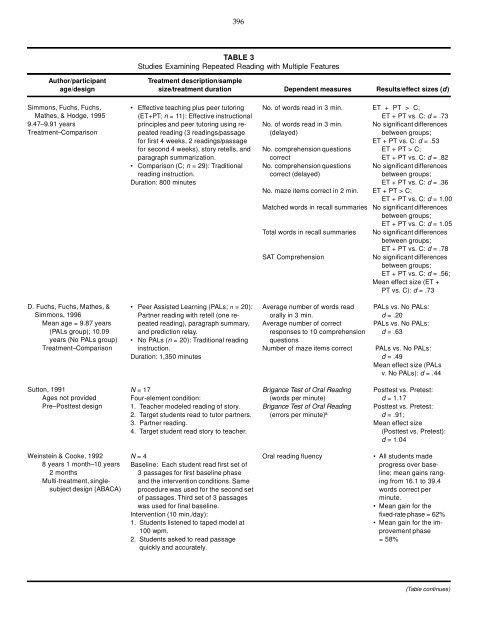A Synthesis of Research on Effective Interventions for Building ...
A Synthesis of Research on Effective Interventions for Building ... A Synthesis of Research on Effective Interventions for Building ...
VOLUME 35, NUMBER 5, SEPTEMBER/OCTOBER 2002 395(Table 2 continued)Author/participantTreatment description/sampleage/design size/treatment duration Dependent measures Results/effect sizes (d )Smith (continued)Vaughn et al., 20008.5–8.8 yearsQuasi-experimentalpretest–posttestcomparison design Modeling with correction and previewing:After modeling, student reread themodeled portion and continued to readfor 5 minutes. Follow-up: Student read passage additionaltime.Length and duration: Not specified, allconditions administered once.Partner Reading (PR; n = 7): Partnerstook turns reading (3 minutes each)with the more pr
396TABLE 3Studies Examining Repeated Reading with Multiple FeaturesAuthor/participantTreatment description/sampleage/design size/treatment duration Dependent measures Results/effect sizes (d)Simmons, Fuchs, Fuchs,Mathes, & Hodge, 19959.47–9.91 yearsTreatment–ComparisonD. Fuchs, Fuchs, Mathes, &Simmons, 1996Mean age = 9.87 years(PALs group); 10.09years (No PALs group)Treatment–ComparisonSutton, 1991Ages not providedPre–Posttest design Effective teaching plus peer tutoring(ET+PT; n = 11): Effective instructionalprinciples and peer tutoring using repeatedreading (3 readings/passagefor first 4 weeks, 2 readings/passagefor second 4 weeks), story retells, andparagraph summarization. Comparison (C; n = 29): Traditionalreading instruction.Duration: 800 minutes Peer Assisted Learning (PALs; n = 20):Partner reading with retell (one repeatedreading), paragraph summary,and prediction relay. No PALs (n = 20): Traditional readinginstruction.Duration: 1,350 minutesN = 17Four-element condition:1. Teacher modeled reading
- Page 9: 394(Table 2 continued)Author/partic
- Page 13 and 14: 398TABLE 4Studies That Examined Oth
- Page 15 and 16: 400JOURNAL OF LEARNING DISABILITIES
- Page 17 and 18: 402JOURNAL OF LEARNING DISABILITIES
- Page 19 and 20: 404JOURNAL OF LEARNING DISABILITIES
- Page 21: 406JOURNAL OF LEARNING DISABILITIES
396TABLE 3Studies Examining Repeated Reading with Multiple FeaturesAuthor/participantTreatment descripti<strong>on</strong>/sampleage/design size/treatment durati<strong>on</strong> Dependent measures Results/effect sizes (d)Simm<strong>on</strong>s, Fuchs, Fuchs,Mathes, & Hodge, 19959.47–9.91 yearsTreatment–Comparis<strong>on</strong>D. Fuchs, Fuchs, Mathes, &Simm<strong>on</strong>s, 1996Mean age = 9.87 years(PALs group); 10.09years (No PALs group)Treatment–Comparis<strong>on</strong>Sutt<strong>on</strong>, 1991Ages not providedPre–Posttest design <strong>Effective</strong> teaching plus peer tutoring(ET+PT; n = 11): <strong>Effective</strong> instructi<strong>on</strong>alprinciples and peer tutoring using repeatedreading (3 readings/passage<strong>for</strong> first 4 weeks, 2 readings/passage<strong>for</strong> sec<strong>on</strong>d 4 weeks), story retells, andparagraph summarizati<strong>on</strong>. Comparis<strong>on</strong> (C; n = 29): Traditi<strong>on</strong>alreading instructi<strong>on</strong>.Durati<strong>on</strong>: 800 minutes Peer Assisted Learning (PALs; n = 20):Partner reading with retell (<strong>on</strong>e repeatedreading), paragraph summary,and predicti<strong>on</strong> relay. No PALs (n = 20): Traditi<strong>on</strong>al readinginstructi<strong>on</strong>.Durati<strong>on</strong>: 1,350 minutesN = 17Four-element c<strong>on</strong>diti<strong>on</strong>:1. Teacher modeled reading <str<strong>on</strong>g>of</str<strong>on</strong>g> story.2. Target students read to tutor partners.3. Partner reading.4. Target student read story to teacher.No. <str<strong>on</strong>g>of</str<strong>on</strong>g> words read in 3 min. ET + PT > C;ET + PT vs. C: d = .73No. <str<strong>on</strong>g>of</str<strong>on</strong>g> words read in 3 min. No significant differences(delayed)between groups;ET + PT vs. C: d = .53No. comprehensi<strong>on</strong> questi<strong>on</strong>s ET + PT > C;correct ET + PT vs. C: d = .82No. comprehensi<strong>on</strong> questi<strong>on</strong>s No significant differencescorrect (delayed)between groups;ET + PT vs. C: d = .36No. maze items correct in 2 min. ET + PT > C;ET + PT vs. C: d = 1.00Matched words in recall summaries No significant differencesbetween groups;ET + PT vs. C: d = 1.05Total words in recall summaries No significant differencesbetween groups;ET + PT vs. C: d = .78SAT Comprehensi<strong>on</strong>No significant differencesbetween groups;ET + PT vs. C: d = .56;Mean effect size (ET +PT vs. C): d = .73Average number <str<strong>on</strong>g>of</str<strong>on</strong>g> words read PALs vs. No PALs:orally in 3 min. d = .20Average number <str<strong>on</strong>g>of</str<strong>on</strong>g> correct PALs vs. No PALs:resp<strong>on</strong>ses to 10 comprehensi<strong>on</strong> d = .63questi<strong>on</strong>sNumber <str<strong>on</strong>g>of</str<strong>on</strong>g> maze items correct PALs vs. No PALs:d = .49Mean effect size (PALsv. No PALs): d = .44Brigance Test <str<strong>on</strong>g>of</str<strong>on</strong>g> Oral Reading Posttest vs. Pretest:(words per minute) d = 1.17Brigance Test <str<strong>on</strong>g>of</str<strong>on</strong>g> Oral Reading Posttest vs. Pretest:(errors per minute) a d = .91;Mean effect size(Posttest vs. Pretest):d = 1.04Weinstein & Cooke, 19928 years 1 m<strong>on</strong>th–10 years2 m<strong>on</strong>thsMulti-treatment, singlesubjectdesign (ABACA)N = 4Baseline: Each student read first set <str<strong>on</strong>g>of</str<strong>on</strong>g>3 passages <strong>for</strong> first baseline phaseand the interventi<strong>on</strong> c<strong>on</strong>diti<strong>on</strong>s. Sameprocedure was used <strong>for</strong> the sec<strong>on</strong>d set<str<strong>on</strong>g>of</str<strong>on</strong>g> passages. Third set <str<strong>on</strong>g>of</str<strong>on</strong>g> 3 passageswas used <strong>for</strong> final baseline.Interventi<strong>on</strong> (10 min./day):1. Students listened to taped model at100 wpm.2. Students asked to read passagequickly and accurately.Oral reading fluency All students madeprogress over baseline;mean gains rangingfrom 16.1 to 39.4words correct perminute. Mean gain <strong>for</strong> thefixed-rate phase = 62% Mean gain <strong>for</strong> the improvementphase= 58%(Table c<strong>on</strong>tinues)



